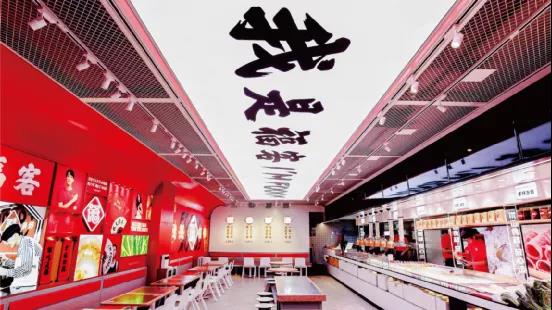Guo Liang, founder of Fork Brand: How to upgrade and iterate catering brands in the new consumption Today's headlines

Guo Liang, the founder of Fooker Brand and a member of the Board of Directors of Pak Fook University, is an entrepreneur with great brand awareness and ingenuity. He has 20 years of business trading experience and more than 10 years of experience in the catering industry. Since the establishment of "Fuke" in 2008, it has adhered to the long-term doctrine and continuously led the innovation of the industry, making Fuke the pioneer of "Hotpot Quality Mala Tang" and the endorsement brand of Mala Tang, a chain directly operated by shopping malls across the country.
At the launching ceremony of the 14th "Digital Intelligence-Iteration" 2021 China Catering Innovation Forum and 2021 China Catering Innovation List selection on May 20, 2021, Fork brand founder Guo Liang brought us the theme "New Consumption Times, How to Upgrade and Iterate Food and Beverage Brands". Based on the 13-year brand development history of Fuke Mala Tang, Mr. Guo proposed the cognition and core methodology for the upgrading and iteration of catering brands, which I believe will inspire everyone in the restaurant.
The following is a transcript of Mr. Guo’s speech, edited by a certain restaurant, with some deletions.
ONE
Brand iteration,
Start with cognitive category changes
Mala Tang is a market segment under the hot pot category, which is different from Chuan Chuan. According to the latest data, Guangdong ranks first in the ranking of provinces for the consumption of Mala Tang. Fortunately, the Fork brand was born in Guangdong and Shenzhen. Among the main consumers of Mala Tang, nearly 80% of the customers are born in the 90s.

The main characteristics and advantages of Chinese spicy tang products are:
1. 99.9% franchise model, tens of thousands of stores. Companies in the Mala Tang category are basically franchising. At present, hundreds of thousands of Mala Tang shops are in a state of 10,000 shops.
2. National cuisine, suitable for north and south. Mala Tang is a national delicacy, and Mala Tang also ranks among the top in search volume on the Internet during the epidemic. Mala Tang category is suitable from north to south, and has no geographical influence.
3. High frequency just needs, non-periodic large single product. Fook's super customers basically come to Fook Mala Tang for dinner every week, with an average consumption frequency of 3-4 times a week. Even in the sweltering summer days in the south in July and August, Fork’s business did not have much off-season and there was no decline in business, and it was very stable throughout the year.
4. Abundant self-selection, strong product malleability. Why do young people now love Mala Tang more and more? Because it can be chosen and matched freely. The bottom of the pot is the customer's choice, the dishes are the customer's choice, and the small ingredients are the customer's tune. Moreover, Fork's upgrade guarantee for the quality of the category is a free and safe choice for young people who pursue individuality and self. Fork’s products are highly malleable. The SKU of the dishes is close to 100. The bottom of the pot keeps 6 styles and is updated every season. At the same time, there are 13 sauces that can be blended. Therefore, whether it is our brand creativity or the customer’s dining structure, it is very strong. The malleability.
The development process of China's spicy tang category: In the past ten years, from the 1.0 model of roadside stalls that promoted small cars, to the street shop 2.0, to the traditional spicy tang franchise chain that developed to 3.0, and then to the 4.0 brand direct sales quality created by Fu Ke Mala Tang chain mode.
The changes in the entire market and consumer demand have also shifted from the initial cheap and big bowls, to the solution of food and clothing while at the same time, to standardized mass fast food, and to light social interaction.
So, what has Fuke Malatang done in the past 13 years? Like all catering brands, Fook has its own unique development experience and encountered many problems in the process. It is just that Fook has always adhered to long-termism, and is constantly trying to solve problems, and in the process of detours and corrections. Continuously reflect and iterate.
Fooker was established in 2008 and was also called Fooker Snack Bar at the time. In 2010, it began to specialize in Fu Ke Mala Tang. After a brand upgrade in 2017, Fork began to officially enter the shopping center. In September 2017, Fook's headquarters moved to Fook Food Planet-a base integrating production, warehousing, logistics and office. In December of the same year, Fooker received investment from Pak Fook Holdings, a subsidiary of Hony. In 2018, Fuke and Tencent jointly opened a smart recommendation restaurant, which landed in Futian Zhuoyue Intown, which attracted the attention of the industry. In the same year, Fook also began to deploy in new retail, with three fast-food products sold throughout the network, with an excellent reputation.
In 2019, Fook and Asia Noodles Company completed a new round of strategic upgrade of the brand and landed in Liancheng Xintiandi. In 2020, Fook's business model has been iteratively upgraded again, and a comprehensive digital construction has begun.
At the beginning of 2021, Fooker officially began to expand nationwide, and has now opened stores in Beijing, Nanchang, Jiangxi, and Nanning, Guangxi, which are loved by consumers.
TWO
Redefine new consumption
New category positioning of the times
In the new consumer era, the upgrading of user needs and the development of brands are irreversible. As Mr. He Jiu said: The catering industry will only have two types of business in the future: larger and larger chain brands, smaller and smaller couples and wife shops: one person in the front hall and one person in the back kitchen.
In the new consumer era, each brand needs to re-establish its own category positioning, namely: what is our product, where are the customers, what unique value is there, and how the brand value is self-consistent and spread. These four aspects are used to position the entire new product. Class of ideas.
At the same time, after doing it, you must correspond one-to-one from the perspective of the customer to determine whether the positioning is self-healing. A good category positioning should meet the corresponding conditions at the same time:
1. Brand name: It must be identifiable, remembered, and recommendable.
2. Core users: clear portraits and real needs.
3. Brand value: It is the first choice of the customer's category and has a strong reason to buy.
4. User value: it can be implemented and customers can perceive it.

Fork’s new category positioning is also based on the above four dimensions:
First of all, the positioning is clear: hot pot quality Mala Tang. All work directions: material selection, material selection, research and development and cooperation, etc. are all working hard around this positioning.
Fork’s core users are young people aged 20-35, 75% of whom are women, and most of their occupations are white-collar workers who pursue a quality life.
Fook is currently the most directly-operated Mala Tang brand with the largest number of stores in shopping malls in the country. I have been doing a direct chain for 13 years.
The communication of the entire brand new positioning system is to reconstruct, upgrade, design and implement the overall business from all dimensions and touch points.
THREE
New positioning requires business
Comprehensive upgrade and iteration of the model
After establishing the positioning of the new category, the most important thing is to land. Fork is working from 5 modules: product, space, experience, digitization and brand.
1. Product: In the new consumer era, user self-propagation is the core KPI
All the pot bottoms of Fooker are researched, planned, and independently developed by the brand department and R&D department from the dual perspectives of the market and users. There are 6 online models and one trendy model every quarter.
Fook has been pursuing product quality, and the quality of raw materials is the foundation.
Each pot bottom is jointly customized with Haidilao Shuhai, whether it is in Shenzhen or the outer area, Shuhai can cover, so the maturity of the entire hot pot category supply chain has brought practical convenience and the possibility of national chaining for Fuke .
This is one of the uniqueness that makes Fu Ke different from any other Mala Tang.
Fuke creates Mala Tang based on hot pot standards. In addition to the bottom of the pot, the ingredients also pursue quality and uniqueness.
Each leafy vegetable is jointly cultivated and custom-grown with the soilless hydroponics base of South China Agricultural University. Hydroponics are better-looking and attractive than soil-cultured vegetables on the senses, and the taste is more tender and nutritious. At the same time, it does not apply pesticides and is environmentally friendly and healthy.
Fook is the first brand in the industry to introduce hot pot premium ingredients into Mala Tang restaurants, such as Australian Snow Beef Beef, Hairy Tripe, Shrimp Roll, Live Shrimp, Fish Roe Lucky Bag and so on. In the entire kitchen cabinet, nearly 30% of the ingredients are customized by Fork. As for the dishes, we also maintain a new rhythm every month. This is another uniqueness of the Fork brand.
Except for Mala Tang, Fukke standard stores are equipped with hand-made snack carts as standard. They sell continuously best-selling products such as childhood sweet and oily fruit, three Chengdu small crispy meat and so on.
Therefore, keeping the product delicious, beautiful, and fun is the key KPI for winning users at the product level of a catering brand.

2. Experience: In the new consumer era, everything needs to be designed with user experience as the center
Fook has always been leading the innovation of the spicy and spicy tang industry, including the first optimal super kitchen cabinet, brand-new display and fresh-keeping mode, and creating a unique selection experience.
Another example is the creation of free self-service counters based on hot pot restaurant standards. Fork's small material is 13 models, and it maintains continuous iteration and innovation.
In terms of dining utensils, Fu Ke created the "Happy Double Ear Pot". It took nearly half a year to customize the pot, and the mold was opened for nearly 10 times, and it was finally made into a bottom width of 19cm, one pot and one hot to restore the original flavor of the ingredients, and matched with our induction cooker, which can effectively improve operating efficiency. appliance. For customers, it is also more like a hot pot, which can enhance the happiness and spread rate of customers after dining.
3. Space: the new consumption era, the value of the brand scene
Fukke attaches great importance to the creation of dining space, and does not compromise the brand because it is a fast-food attribute. From the upgraded MUJI style in 2017 to the national tide style upgraded again in 2019, the atmosphere is more lively, the dining scene is more comfortable and bright, and the store has also been upgraded from more than 70 square meters to more than 100 square meters, which has attracted consumers. Favorite.
Fork’s Urban PRO store type is a "spicy spicy + model exploration". It has already launched its first store in Beijing and Tianan Yungu, adding barbecue. Such a combination can satisfy the consumer psychology of contemporary young people who want it, want it at the same time, and want it immediately, and it is also effective in generating revenue for the store.
At the end of 2020, Fook launched a brand concept store: Fook Mala Tang Academy. At that time, many catering and business colleagues in this concept store also came to give guidance, and Fuke also held a large-scale press conference. This store has fully implemented all the products developed by Fooker in the past 13 years, and conducted product research and production in a branch-by-department manner. At the same time, this store is also an offline training base for the core employees of Fooker's national stores, and a home base for Fooker's super users "enthusiasts".
4. Brand: In the new consumer era, mind + content + values = brand access ticket
When the Fuke brand was founded, the original intention and vision were Chinese elements, Chinese catering, and Chinese classic snacks, so it focused on the "Fu" culture.
Therefore, the "Fuke" LOGO has become a logo that resembles the "Fu".
The brand value proposition "I am Fork" is mainly in stores.
At the same time, Fook will also make some cultural and creative products, such as creative surroundings around the workplace, solar terms or cultural themes, such as canvas bags, coasters, brain stickers and so on.
At the level of brand marketing and user operations, we attach great importance to interaction with young people. For example, the monthly "One Second User Photography Contest" is held online, the "Fuke Workplace Ideal Pawnshop Pop-up Shop" and the "Fuke Youth City Exploration Project" are held offline.
5. Digitization: In the new consumer era, full-link digitization is the key to continued brand growth
Since the beginning of the epidemic last year, Fuke has focused on digital construction. We have conducted in-depth cooperation with Hulaala, which provides support for our business decision-making from the aspects of supply chain, business data, membership data and marketing activities, including: store business analysis, supply chain analysis, product strategy, marketing campaign strategy, etc.
In addition, Fork has established the digitization of the overall business based on the WeChat ecosystem, and has established a brand traffic pool and user operation system through small programs, member malls, corporate WeChat, hierarchical communities, and social media.
The next 10 years will be the golden 10 years for catering, the most beautiful 10 years, but also the most cruel 10 years. Food and beverage brands can only realize the dream of each of our brands if they continue to keep diligently, keep up with the pace of the times, make themselves better, upgrade and iterate continuously, and make the company bigger and stronger. Let us witness the bright future of the catering industry together! Caterer, come on!
免责声明:1.餐饮界遵循行业规范,转载的稿件都会明确标注作者和来源;2.餐饮界的原创文章,请转载时务必注明文章作者和"来源:餐饮界www.canyinj.com",不尊重原创的行为餐饮界或将追究责任;3.投稿请加小编微信toutiaoxiansheng或QQ1499596415。4.餐饮界提供的资料部分来源网络,仅供用户免费查阅,但我们无法确保信息的完整性、即时性和有效性,若网站在使用过程中产生的侵权、延误、不准确、错误和遗漏等问题,请及时联系处理,我们不承担任何责任。
 扫码关注餐饮界微信号
扫码关注餐饮界微信号
- Quanjude is expected to lose 4
- Small restaurants can’t do it
- Haidilao, which has reported h
- Goubuli Baozi's last store in
- Měi gè cāntīng fúwùyuán, dōu s
- With 100 semi-finished stores
- With a valuation of tens of bi
- In the face of the enemy, is D
- Haidilao, which removes beef c
- What are the factors that must


 Media
Media


